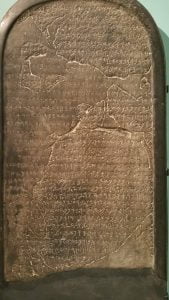
This is a replica of the (mostly) original Stele, housed in the Louvre in Paris.
The smoother surfaced parts are created based on the paper sketch, while the rougher fragments are the originals as they are today.
The Mesha Stele was found in Dibon, Jordan in August 1868 by a missionary. Pretty soon people realized this was very valuable and the Berlin Museum and the French Consulate got into a bidding war. The next year some local Arabs, realizing all that was at stake, laboriously hoisted it out of the earth and lit a fire around it, and after pouring cold water on it they chipped away several large pieces which they distributed among a few of them. Later the French re-assembled 669 of the estimated 1100 consonants from the pieces and preserved the inscription. It now remains in the Louvre Museum in Paris.
The stone is written in Moabite, and refers to the “House of Omri”, Yahweh, and the “House of David.” The Bible talks about Mesha
2 Kings 3:4 And Mesha king of Moab was a sheepmaster, and rendered unto the king of Israel an hundred thousand lambs, and an hundred thousand rams, with the wool. 5 But it came to pass, when Ahab was dead, that the king of Moab rebelled against the king of Israel.
This stele says “Omri was king of Israel, and oppressed Moab during many days, and Chemosh was angry with his aggressions. His son succeeded him, and he also said, I will oppress Moab.”
During this battle Jehoshaphat joined Ahab, and they ran out of water, and Elisha told them to dig ditches (2 Kings 3:16).